Trying to outwit the deer is a lifelong challenge for those of us who live in deer country. Just when we think we understand their fickle tastes, they develop a liking for something new. The phrase “deer will eat anything when hungry enough” is certainly true, but personally I think they can read price tags. Deer always seem to eat the most expensive specimens.
Let’s be clear — there are levels of deer resistance. There are plants that will get eaten to the ground every year; those that are moderately grazed, but at least enough of the plant gets left that it’s still worth growing them; and those that are rarely, if ever, touched. I have also noticed that some that are considered deer resistant have their new growth and/or flowers eaten, although the less tender parts of the plant stay safe. Taste also varies according to region and the age of deer (young ones really will try anything).
I live in the Pacific Northwest, but several of these suggestions are hardy to zones 3 and 4. The aim is for the
plants to bring drama to the garden, not the deer. The plants highlighted here have experienced little if any damage in my garden to date.
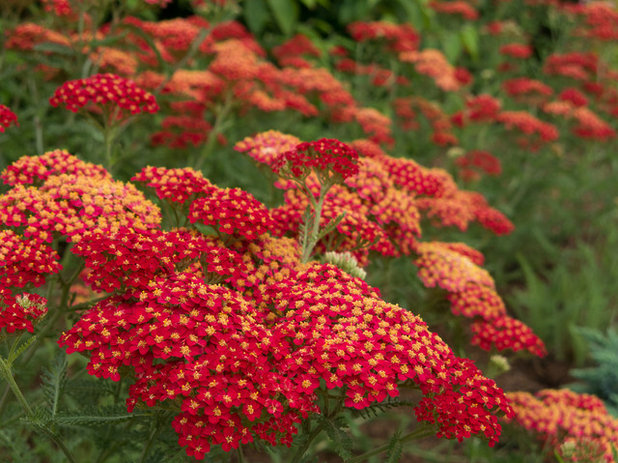
Le jardinet
Paprika Yarrow(
Achillea millefolium ‘Paprika’)
Paprika opens with spicy-hot color, as shown here, then fades to shades of terra-cotta. The color lasts for many weeks, and if you take the time to deadhead the old flowers, it will continue to bloom from June to October. Yarrow is inexpensive, which makes it a great choice for massing in the border.
Origin: The species is native to Europe, but Paprika is a garden hybrid
Where it will grow: Hardy to -40 degrees Fahrenheit (USDA zones 3 to 8; find your zone)
Water requirement: Low
Light requirement: Full sun
Mature size: 12 to 18 inches tall and 2 feet wide
Benefits and tolerances: Tolerates drought and poor soil; low maintenance; attracts butterflies and bees
Seasonal interest: Summer
When to plant: Spring
Planting notes: Needs well-drained soil
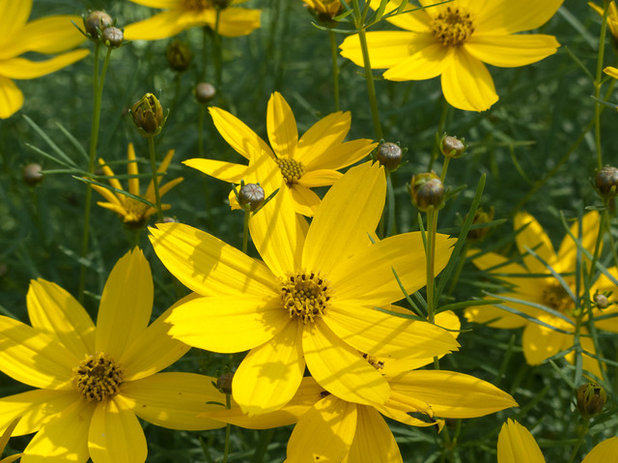
Le jardinet
Zagreb Tickseed(
Coreopsis verticillata ‘Zagreb’)
Who can resist a splash of sunshine? That’s just what this tickseed brings to the summer garden, with its golden daisy-like flowers. Feathery foliage makes this a perennial that is attractive even when not in bloom.
Origin: Threadleaf tickseed is native to the southeastern United States, but the cultivar Zagreb is a garden hybrid.
Where it will grow: Hardy to -40 degrees Fahrenheit (USDA zones 3 to 9)
Water requirement: Low
Light requirement: Full sun
Mature size: 2 feet tall and wide
Benefits and tolerances: Low maintenance; drought tolerant
Seasonal interest: Summer to fall
When to plant: Summer or fall
Planting notes: Plant it in average, well-drained soil.
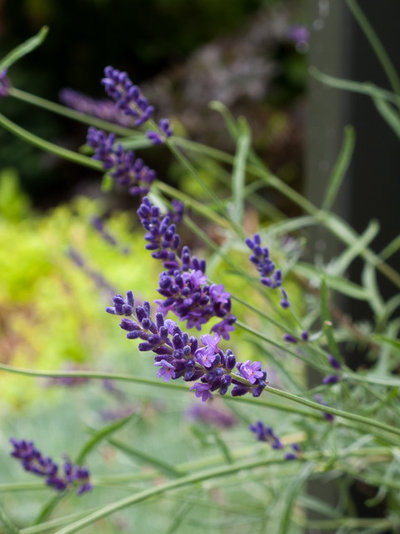
Le jardinet
Hidcote Lavender(
Lavandula angustifolia ‘Hidcote’)
Lavender is a woody perennial, meaning that the twiggy structure remains aboveground over the winter. There are many varieties to choose from, with leaves in shades of gray, green, silver and even some variegated forms. The flowers come in shades of blue, purple, white or pink.
If lavender isn’t hardy in your area, try one of these blue-flowering perennials that the deer also seem to ignore: Sages (
Salvia spp), Russian sage (
Perovskia atriplicifolia) and catmint (
Nepeta spp).
Origin: The species is native to the Mediterranean, but Hidcote was hybridized at Hidcote Manor in England.
Where it will grow: Hardy to -20 degrees Fahrenheit (USDA zones 5 to 9)
Water requirement: Low
Light requirement: Full sun
Mature size: 2 feet tall and wide
Benefits and tolerances: Makes great cut flowers and dries well; fragrant; attracts bees and butterflies
Seasonal interest: Year-round
When to plant: Spring
Planting notes: Plant it in well-drained soil and do not mulch near the crown.
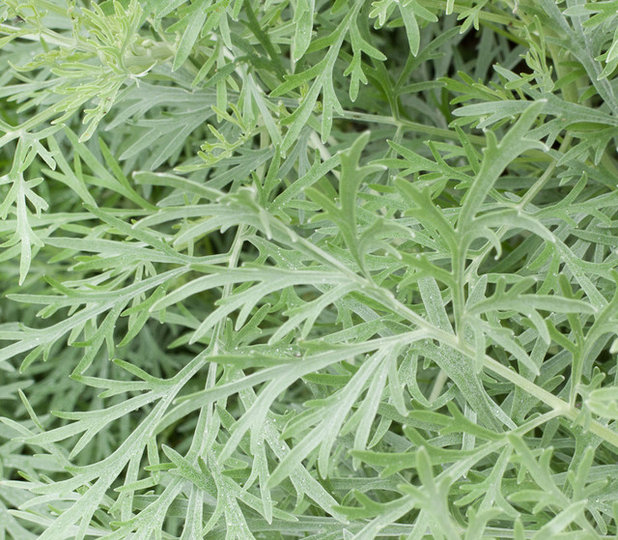
Le jardinet
Silver Mound Wormwood(
Artemisia schmidtiana ‘Nana’)
Silver mound wormwood is all about the foliage. Its soft cushions of feathery silver foliage really dress up the summer garden and look wonderful with any other color — from orange to soft pink.
Origin: Japan
Where it will grow: Hardy to -30 degrees Fahrenheit (USDA zones 4 to 9)
Water requirement: Low
Light requirement: Full sun
Mature size: 2 feet tall and wide
Benefits and tolerances: Fragrant foliage; drought tolerant
Seasonal interest: Spring to fall
When to plant: Spring
Planting notes: Plant it in well-drained soil; cut off one-third of the foliage partway through summer to maintain a tidy shape if desired.
See planting ideas for silver mound wormwood
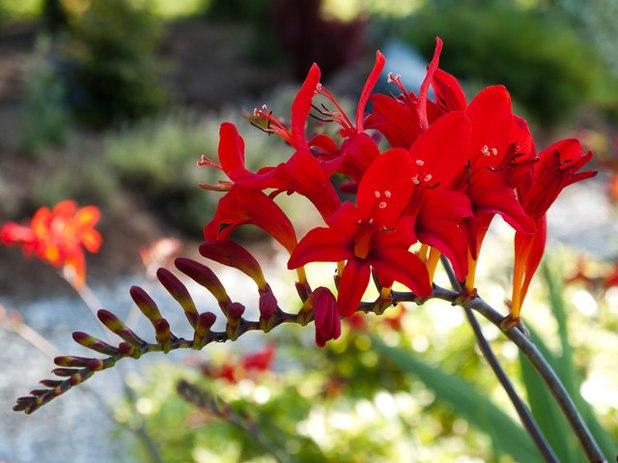
Le jardinet
Lucifer Montbretia(
Crocosmia ‘Lucifer’)
Lucifer montbretia brings drama with both its stature and color. This perennial bulb is a hummingbird favorite that should be in every garden, whether you struggle with deer or not.
If Lucifer won’t work with your color scheme, there are several other kinds of Crocosmia to choose from with flowers and foliage in varying shades.
Origin: The species is native to South Africa, but Lucifer is a garden hybrid
Where it will grow: Hardy to -20 degrees Fahrenheit (zones 5 to 9)
Water requirement: Low
Light requirement: Full sun
Mature size: 3 feet tall and wide
Benefits and tolerances: Attracts hummingbirds; makes a great cut flower; drought tolerant
Seasonal interest: Summer to fall
When to plant: Spring
Planting notes: Plant it in well-drained soil; you may need to protect it from rabbits until it reaches around 1 foot tall.
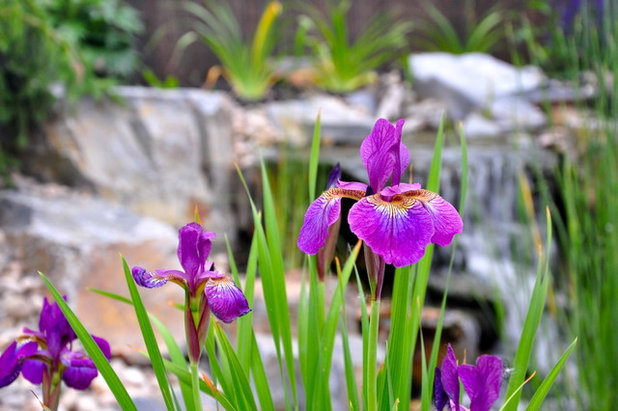
Pacific Ridge Landscapes Ltd
Siberian Iris(
Iris siberica)
Deer seem to ignore all irises. I selected the Siberian species here simply because the foliage is softer and more grass-like than that of bearded iris, and I have found it to be easier to care for — or rather to forgive my neglect more readily.
Origin: Asia and Europe
Where it will grow: Hardy to -30 degrees Fahrenheit (USDA zones 4 to 7)
Water requirement: Average to moisture-retentive soil
Light requirement: Full sun or partial shade
Mature size: 3 feet tall and wide
Benefits and tolerances: Makes a great cut flower
Seasonal interest: Spring to fall
When to plant: Spring or fall
Planting notes: Siberian iris needs dividing every three to four years.
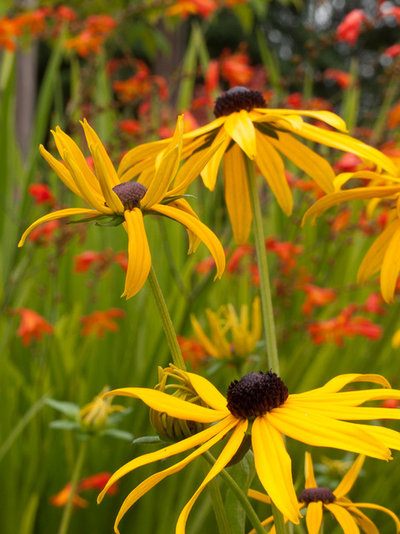
Le jardinet
Black-Eyed Susan(
Rudbeckia fulgida var.
sullivantii ‘Goldsturm’)
Don’t be a plant snob. Black-eyed Susan may be ubiquitous in summer gardens, but that doesn’t mean it is not worth growing anymore. I have a large swath of it surrounding a small cedar cabin, and it is truly a stunning highlight of the late-summer garden. So far the plants have never been nibbled by deer, or if they have, there are so many flowers that I have never noticed.
Origin: The species is native to North America, but this is a garden hybrid.
Where it will grow: Hardy to -10 degrees Fahrenheit (USDA zones 6 to 10)
Water requirement: Low
Light requirement: Full sun or partial shade
Mature size: 3 feet tall and wide but spreads
Benefits and tolerances: Makes a great cut flower; drought tolerant; low maintenance
Seasonal interest: Summer to fall
When to plant: Spring or fall
Planting notes: Plant it in average, well-drained soil; will spread easily, so may need dividing very few years.
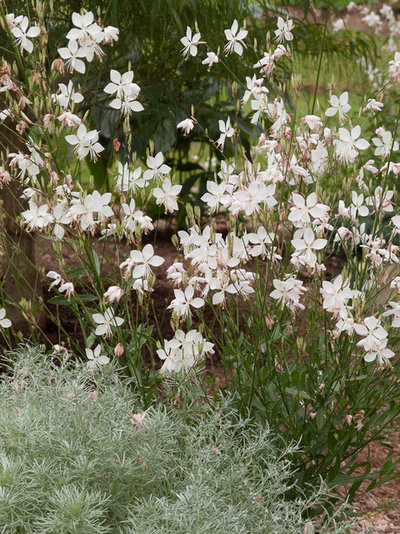
Le jardinet
Whirling Butterflies(
Gaura lindheimeri)
A haze of these delicate flowers is a summer delight from late May to October; they’re reminiscent of white whirling butterflies. My personal favorite is the species shown here, but there are many varieties to choose from, including ones with burgundy leaves and pink flowers. I run a ribbon of these through the middle of the border, and they always perform well, providing the winter is not excessively wet.
Origin: Louisiana to the desert Southwest and south into tropical Mexico
Where it will grow: Hardy to -20 degrees Fahrenheit (USDA zones 5 to 9)
Water requirement: Low
Light requirement: Full sun
Mature size: 3 feet tall and wide
Benefits and tolerances: Drought tolerant; long bloom time; low maintenance
Seasonal interest: Summer to fall
When to plant: Spring
Planting notes: Plant it in well-drained soil; do not cut down the stems until spring, when new growth is observed and the danger of a hard frost has passed
See how to create a romantic entry garden with Whirling Butterflies
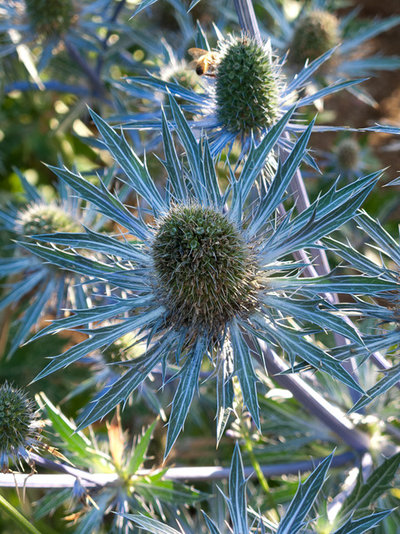
Le jardinet
Sapphire Blue Sea Holly(
Eryngium ‘Sapphire Blue’)
Sea holly is another perennial for every garden, and although there are many newer varieties available, Sapphire Blue is still one of my favorites.
The spiky metallic blue bracts definitely bring drama to the summer garden, as well as many bees, who seem to favor this over adjacent plants.
Origin: Sea holly is native to northern Africa, Europe and Asia, but Sapphire Blue is a garden hybrid
Where it will grow: Hardy to -20 degrees Fahrenheit (USDA zones 5 to 9)
Water requirement: Low
Light requirement: Full sun
Mature size: 3 feet tall and 2 feet wide
Benefits and tolerances: Attracts bees; makes a great cut flower and dries well; drought tolerant; low maintenance
Seasonal interest: Spring to fall
When to plant: Spring or fall
Planting notes: Plant it in well-drained soil.
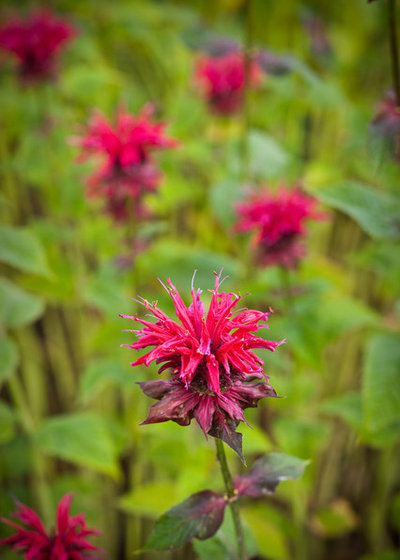
Ginkgo Leaf Studio
Jacob Cline Bee Balm(
Monarda didyma ‘Jacob Cline’)
Bee balm is perhaps more about reliability than drama. It’s an old-fashioned perennial with a workhorse attitude, aromatic foliage and dozens of fuzzy flowers that bees and butterflies love — and that thankfully the deer don’t.
Origin: Native to North America
Where it will grow: Hardy to -30 degrees Fahrenheit (USDA zones 4 to 9)
Water requirement: Low
Light requirement: Full sun or light shade
Mature size: 3 to 4 feet tall and wide
Benefits and tolerances: Attracts bees and butterflies; makes a great cut flower; drought tolerant; low maintenance
Seasonal interest: Summer
When to plant: Spring or fall
Planting notes: Plant it in average, well-drained soil; it may need dividing every few years.
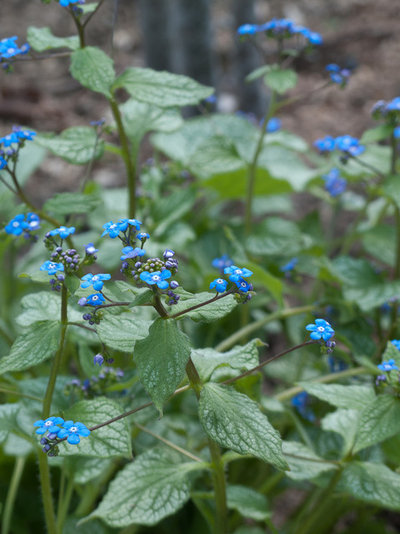
Le jardinet
Jack Frost Siberian Bugloss(
Brunnera macrophylla ‘Jack Frost’)
Silver-veined, heart-shaped leaves from early spring until late fall and blue forget-me-not-like flowers in April and May make Jack Frost a joy to have in any garden.
Origin: The species is native to the Caucasus Mountains in Eurasia, but Jack Frost is a garden hybrid.
Where it will grow: Hardy to -40 degrees Fahrenheit (USDA zones 3 to 8)
Water requirement: Average to low
Light requirement: Partial shade
Mature size: 18 inches tall and wide
Benefits and tolerances: Drought tolerant once established; makes a great cut flower; low maintenance
Seasonal interest: Spring to fall
When to plant: Spring or fall
Planting notes: Plant it in average, well-drained soil.
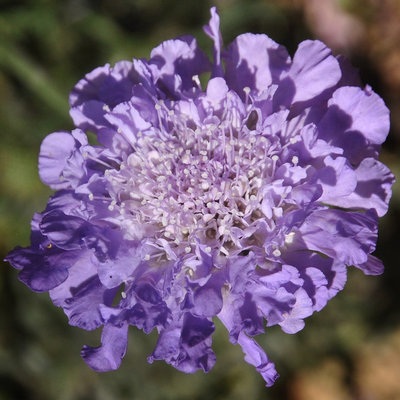 Butterfly Blue Pincushion Flower
Butterfly Blue Pincushion Flower(
Scabious columbaria ‘Butterfly Blue’)
Isn’t it wonderful when you can include flowers as beautiful as this in your deer-patrolled garden? This looks especially beautiful planted near black foliage, such as one of the darker-leaved varieties of bugbane (syn snakeroot,
Acteae syn
Cimicifuga), which the deer also seem to ignore.
Origin: The Mediterranean, Western Asia and North Africa; Butterfly Blue is a garden hybrid.
Where it will grow: Hardy to -40 degrees Fahrenheit (USDA zones 3 to 9)
Water requirement: Average
Light requirement: Full sun
Mature size: 1 foot tall and wide
Benefits and tolerances: Makes a great cut flower; attracts butterflies
Seasonal interest: Summer
When to plant: Spring
Planting notes: Plant it in moisture-retentive soil.
No list is absolute, but this is my tried and tested top dozen perennials. Out of them all, I have had only two Lucifer montbretia flowers nibbled one year. Other species and varieties of the same plants are likely to be equally deer resistant, but these are the ones I have personal experience with.
Tip: Keep a reference of deer-resistant plants in the car for impromptu nursery visits. I find the list by Rutgers to be a good general guide, even if I have found some discrepancies in my own garden.





